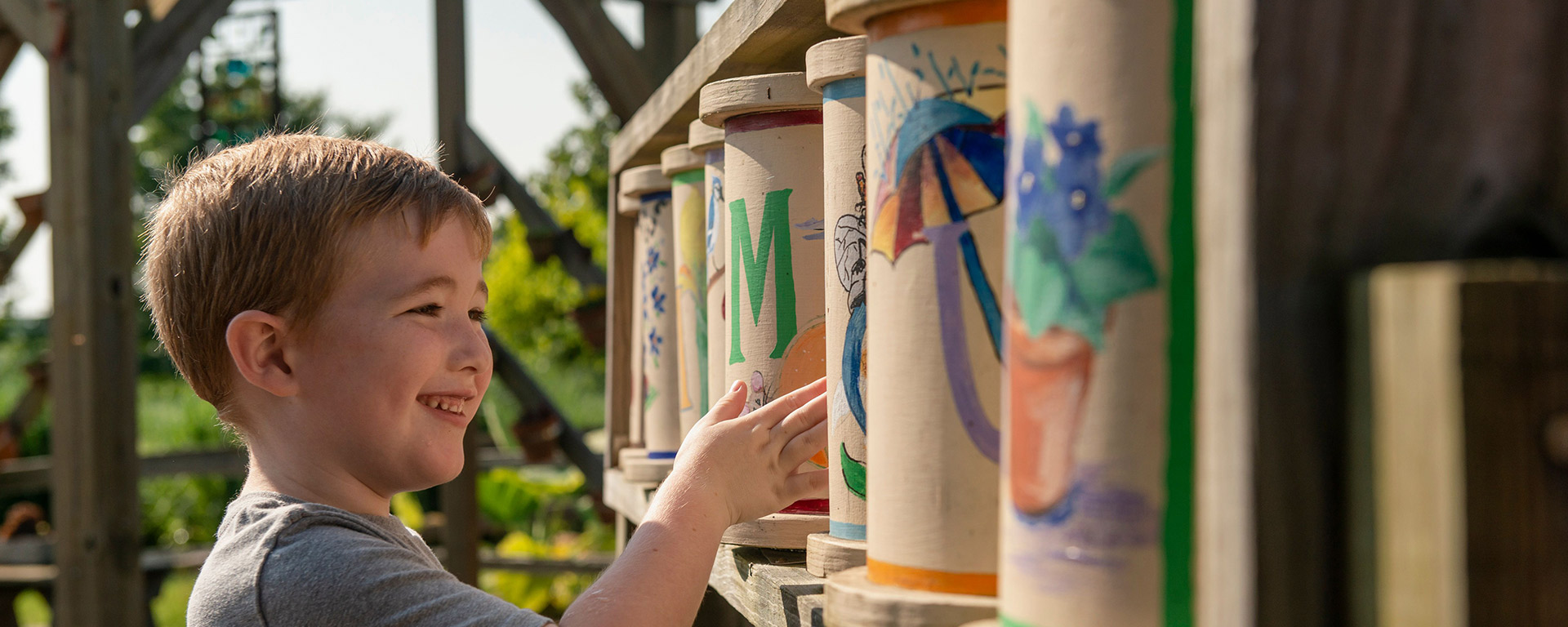American philosopher Henry David Thoreau wrote
“It is the marriage of the soul with nature that makes the intellect fruitful, and gives birth to the imagination.”
It’s that sentiment that makes the UT Gardens such fertile ground for artwork that inspires learning, contemplation and happiness.
The four UT Gardens—the UT Gardens on the Knoxville campus, the UT GATOP Arboretum and Education Center in East Knoxville, the Plateau Discovery Gardens at the Plateau AgResearch and Education Center in Crossville, and the UT Gardens at the West Tennessee AgResearch Center in Jackson—are collectively designated as the State Botanical Garden of Tennessee.
Here’s a look at a notable piece of artwork that graces each garden:
Plateau Discovery Gardens, Crossville: KinderGarden
The Cumberland County Master Gardeners are the nature artists who built and help maintain the UT’s Plateau Discovery Gardens. One of the group’s creative masterpieces is the KinderGarden, an area designed for visitors ages 3 to 7.
In the KinderGarden, children can spin brightly painted alphabet wheels; they can work a mural puzzle, matching critters with their tracks; and they can open doors on another mural to see animals that live in and under a tree. There is a water play station with a hydraulic pump and a learning cottage stocked with wooden building blocks, magnifying glasses, musical instruments, games, books and more.
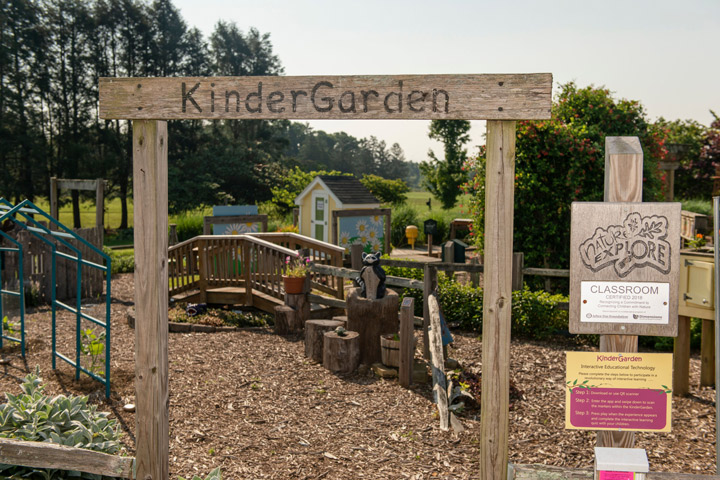
The KinderGarden opened in 2015. It received a Search for Excellence Award in the Youth Category from the Tennessee Master Gardener Association in 2016 and was recognized as a certified Nature Explore Outdoor Classroom in 2018.
To have a space like that to make the gardens fun and educational for the kids is huge,” says Shalena Durkot, coordinator for the gardens at the Plateau AgResearch and Education Center, off Highway 70.
The Plateau Discovery Gardens were started by Master Gardeners in 2005. The gardens now feature 31 exhibits, including a rain garden, an herb garden and human sundial, and a butterfly garden.
UT Gardens, Knoxville: Two Arcs
Nestled in the shadows of four giant oak trees in the UT Gardens, Knoxville, Two Arcs looks right at home.
The gardens’ newest permanent artwork, Two Arcs, is a 10-foot-by-10-foot-by-8-foot wooden sculpture created by Arizona physician-turned-artist Matt Baral. It came to UT Gardens in 2021 as part of the Dogwood Arts’ Art in Public Places program. In June, UT Gardens Interim Director James Newburn appealed to supporters to help purchase the much-loved piece for $3,800 so it could stay.
“This organic, redwood sculpture is interpreted by viewers in so many ways,” Newburn says. “Some people see in the sculpture the peaks of our beloved Smoky Mountains or the wings of the butterflies in the nearby Monarch Waystation. Some think in more abstract terms and feel the joints of the piece represent the myriad directions life’s journey can take.”
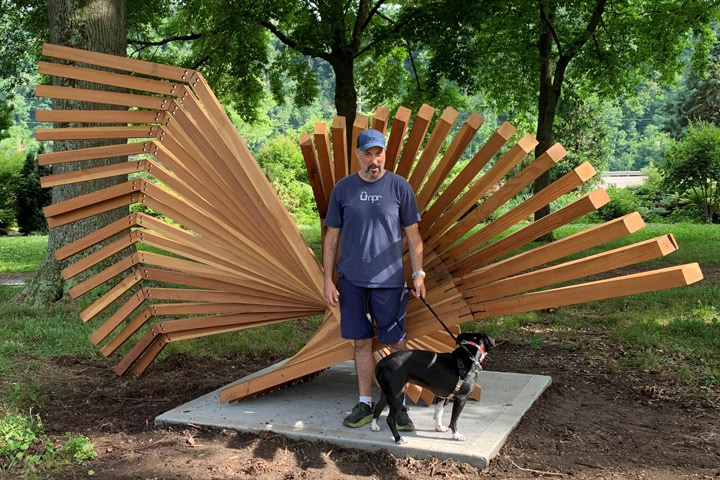
The story of Two Arcs is as special as the piece itself.
After 21 years as a naturopathic pediatrician, Baral retired his medical license and enrolled in the MFA program at Arizona State University. He continues to teach medical students, and his love of art and nature meld with his love of medicine.
Baral says his wood sculptures feature repetitive forms “much like we see things built in the natural world.”
Two Arcs was commissioned by Arizona State University’s School of Law for a special event. After its six-month display, it was chosen for the Dogwood Arts exhibit.
Baral transported the pieces of sculpture to Knoxville on a trailer. He and Newburn assembled it.
“It’s the most harmonious location for my work to date,” Baral says. “You build something that speaks to you with hopes that other people can understand, too.”
UT GATOP Arboretum and Education Center: Graft Knoxville
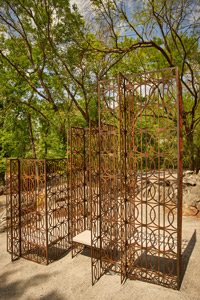
Graft Knoxville is the first sculpture at UT GATOP Arboretum and Education Center, a stretch of wooded hills in East Knoxville and the newest addition to the State Botanical Garden.
Graft Knoxville was designed by noted Puerto Rican artist Edra Soto, who lives in Chicago. The project was curated and managed by Tri-Star Arts, a nonprofit program that promotes public art in Tennessee.
The sculpture “is about migration,” Soto says. “The project allowed me to speak about my condition (as an immigrant).”
Graft Knoxville sits in an area strewn with enormous chunks of marble left from the old Morrow’s Quarry. Benches carved
from one of the 19th-century abandoned blocks of marble are set into three 10-foot-tall interlocking steel frames with geometric designs reminiscent of window bars common in Puerto Rico.
It is “a perfect reflection of Edra’s Puerto Rican heritage, and it fits the site perfectly,” says Andy Pulte, distinguished lecturer and executive director of UT GATOP.
Using Soto’s blueprints, UT Knoxville students, staff and faculty helped build the sculpture. The project partners included Dr. Alan Solomon, Johnson & Galyon Construction, Mallia Engineering Co., Sanders Pace Architecture, Tennessee Marble Co., UT Fab Lab and UT’s Department of Plant Sciences, School of Art and the sculpture program.
Soto, who attended the public unveiling in May, says she believes Graft Knoxville creates “a nice conversation with the nature surrounding the structure.”
UT GATOP is currently only open to the public for special events.
UT Gardens, Jackson: Bottle Wall
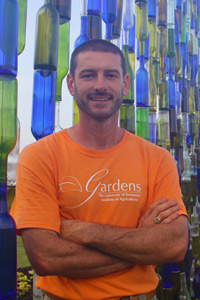
The colorful bottle wall may be the perfect symbol of the ingenuity and collaborative efforts that make UT Gardens, Jackson, so special.
“It’s the most noted and noticeable” piece of garden art, says Jason Reeves, a research horticulturist who has spent nearly 20 years as curator
of the gardens on the grounds of the UT West Tennessee AgResearch and Education Center (WTREC).
Reeves built the wall in 2014 after helping some friends construct a small bottle wall in their yard. Their inspiration came from a Facebook photo.
The result was so awesome that Reeves knew he wanted to build a larger version for the gardens.
Always a collector, Reeves has made nearly all of the gardens’ art by repurposing items, including bed springs, barbed wire, used mailboxes, old cookstoves and neckties. His mission is to keep expenses down while creating pieces that generate a buzz and bring visitors to the gardens. He shares his passion for recycling in a presentation called “Trash to Treasure,” which he’s given more than 40 times—at national associations, professional conferences, garden clubs and Extension meetings from Maryland to Mobile, Alabama.
The Bottle Wall is 44-feet long, 12-feet tall and contains 1,000 wine bottles. WTREC staff built the frame from parking-lot lamp posts felled by a tornado. The Madison County Master Gardeners spent countless hours washing donated wine bottles, and student workers helped string and hang the bottles.
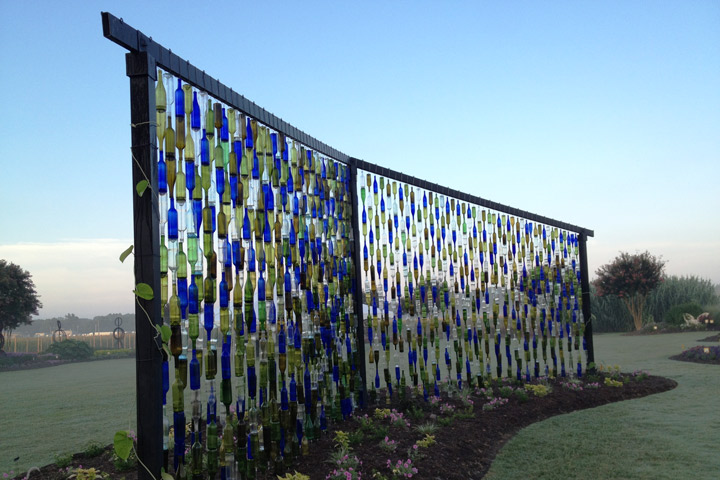
Reeves said the wall cost only about $500. The only purchased materials were stainless steel cable, drill bits for making holes in the bottles, crimping supplies to tighten and secure the cables, and about 100 tough-to-find blue bottles that cost $1.50 each.
Unfortunately, the wall was damaged in the March tornado; repairs will be made this winter when things are slower in the gardens.
